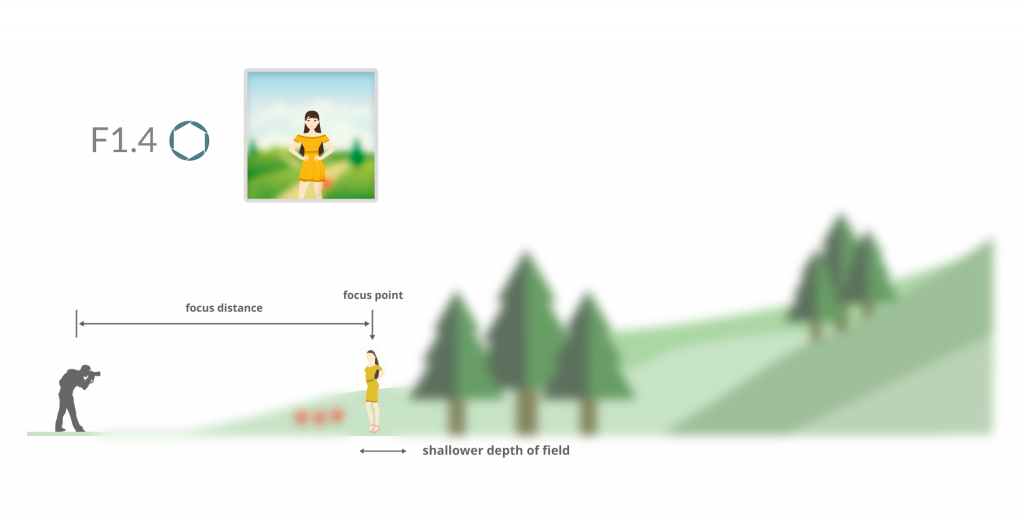- Total354
- Facebook323
- Pinterest21
- Email10
How To Achieve A Perfectly Blurred Background Every Time
You’ve seen those photos where the background is super blurry and the subject is incredibly crisp and in focus.

Photoshop magic, you say?
You may find this surprising, but that type of photo is not typically created in Photoshop or another photo editing application during post-processing.
It is simply an effect that is achieved entirely in camera.
Yep, you heard me right. The blurry background effect you’re looking for is achieved in camera by a shallow depth of field.
Some people like to call this the bokeh effect, so I’ll definitely touch on that as well.
Ready to learn more about this concept so you can master it in your next photoshoot?
Great! Let’s start with depth of field & bokeh, which I also cover extensively in my blog post on aperture.
Depth of Field
Depth of field is the amount of space or distance that is IN focus.
It is not where you focus, but how much of the image that is in focus.
To learn more about how aperture controls depth of field, check out part 4 of my 12-part video series on aperture.
That was just one video from my free aperture video series. Click here to watch all of them in The Ultimate Guide To Aperture.
Imagine you are taking pictures of your daughter at a greenhouse. There are plants around her and she’s wearing a bright red dress. You want to capture her beauty in a way that makes her infectious joy POP.
Since she is your subject in this scenario, you are likely going to focus on her bright eyes before taking the shot. Of course, you could choose to focus specifically on her nose instead, or something she is wearing, or her shoes if you wanted!
Depth of field is how much of the foreground and background are in focus around her eyes (or whatever point you are focused).
You can have a very large depth of field, or a very shallow depth of field.
If all the plants behind your daughter look crisp and in focus in addition to her face, you have a deep or large depth of field. There is a greater amount of space around her in focus.


If the plants behind her look blurred, creamy, and out of focus, but her smiling face is sharp, you have a achieved a shallow depth of field. There is a smaller, more limited amount of space around her in focus.


Both of these image scenarios are accomplished in camera, but because this article is geared toward getting that perfectly blurry background, we’re going to “focus” (pun always intended) on achieving a shallow depth of field today.
(Shhh – if you want a sharp background, you can do the exact opposite of what I explain below to achieve a larger depth of field… )
Stay tuned for the 3 key factors to getting a blurry background…
Bokeh
Bokeh is the photography term attributed to the texture or aesthetic quality of the blurriness of a photo’s background.
It’s that creamy dreamy background blur that everyone’s after, especially when shooting portraits.
Determining this aesthetic quality of the out of focus parts of an image is fairly subjective to the photographer.
The shallower the image, the “smoother” the bokeh. It all comes back to a shallow depth of field, and I’ve got 3 key factors to share with you!
Let’s recap first:
- A sharp background is actually referencing a deep/large depth of field. When you take a portrait in which the background of the subject is as clear and in focus as the subject’s face and eyes, you have a large depth of field.
- A blurred background is actually referencing a shallow depth of field. When you have a portrait in which the subject’s face and eyes look crisp and in focus but the background is blurry or creamy, you have a shallow depth of field. The quality of this shallow depth of field can also be called bokeh!
Ready to learn the tricks of this in camera effect so you can shoot like the pros?
3 Key Factors to Creating a Blurry Background:
1. Aperture
Understanding and adjusting the aperture is the easiest way to control whether the background of your image is blurry (or sharp). This can be greatly used in most portrait and even food photography.
Hold up. What is aperture?! Allow me to introduce you.
A larger sized hole creates a shallower depth of field, which results in a blurrier background.
Got it. How do I get a shallower depth of field using aperture? Lower your f-stop to get a larger hole, which will let more light in.
Here is a chart to see how f-stops affect the aperture.
For example, F2.0 or F1.4 will give you a very nice blurred background – especially great for portraits!
To learn more about how to control your aperture with f-stops (plus everything else you could possibly want to learn about aperture), check out this epic post.
2. Zoom*
The closer you are zoomed into your subject, the blurrier the background will be, regardless of your aperture/the f-stop number, etc.
3. Proximity*
The closer you physically step toward your subject, the blurrier the background will become.
*Essentially, the closer you are to your subject (whether by zooming in on your subject or by physically moving closer to your subject), the blurrier your background will be.
The direct opposite is true for a sharp background. Just reverse each key factor and go!
Shallow Depth of Field = Blurry Background
Deep Depth of Field = Sharp Background
Now You Know
Most blurry backgrounds you see are NOT achieved through slick Photoshop skills, but rather directly in your camera!
You can achieve this creamy dreamy effect by adjusting the aperture (measured in f-stops), zooming in on your subject, and/or moving closer to your subject.
I want to see you guys giving these 3 factors a try to produce a shallow depth of field. Share your photos and what you learned in the comments below!
New to this whole photography scene or wanting to brush up on your skills? I have a FREE online training called Show Your Camera Who’s Boss and would love to see you there!
- Total354
- Facebook323
- Pinterest21
- Email10






3 thoughts on “How To Achieve A Perfectly Blurred Background Every Time (+ FREE Video Aperture Series)”
The video ended fast at the end on your video and I didn’t get to download my free 7 day trial a so sad
Send me your email secret plz
Hi Tammy! I’m so sorry about that! Can you send an email to [email protected] so we can assist? 🙂